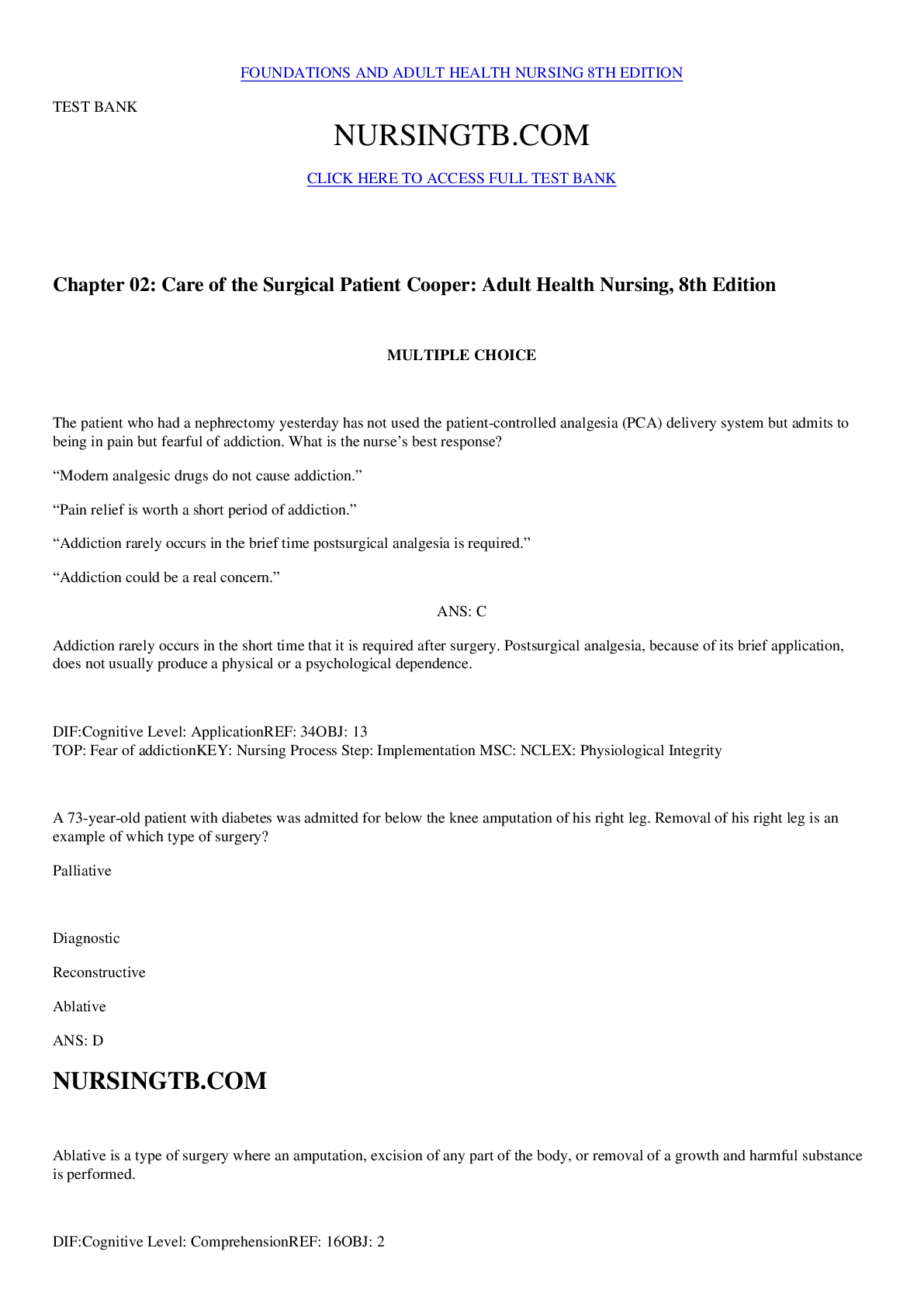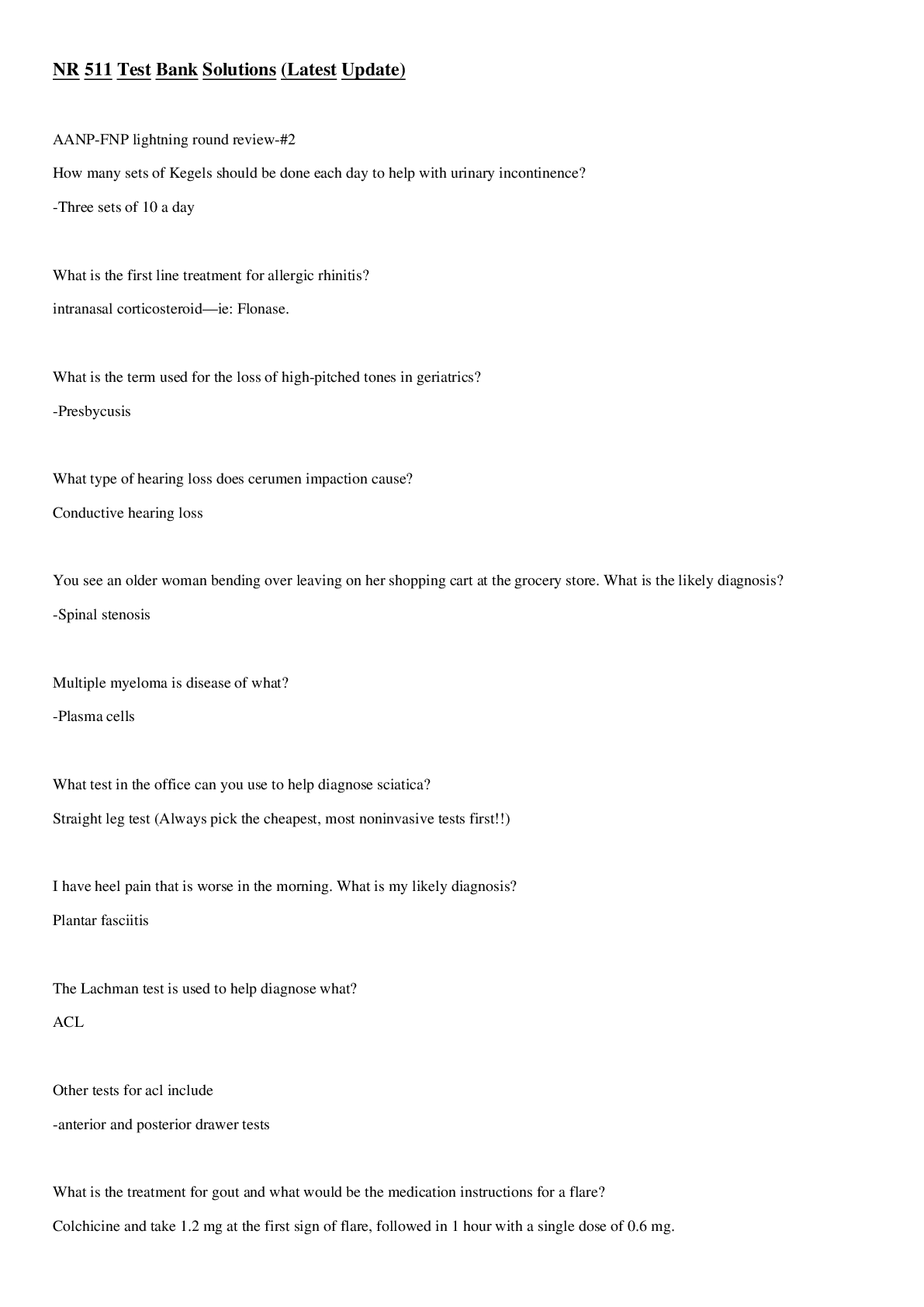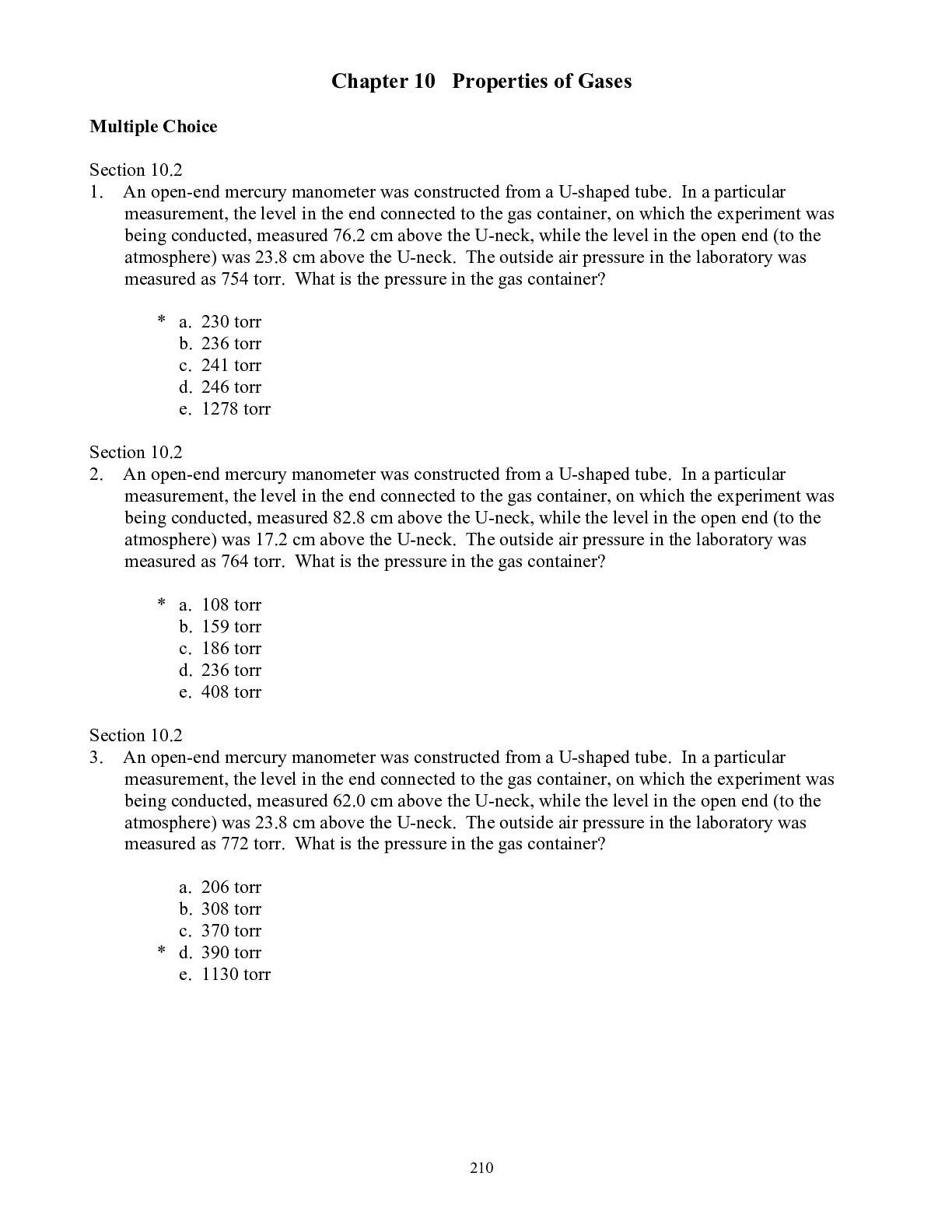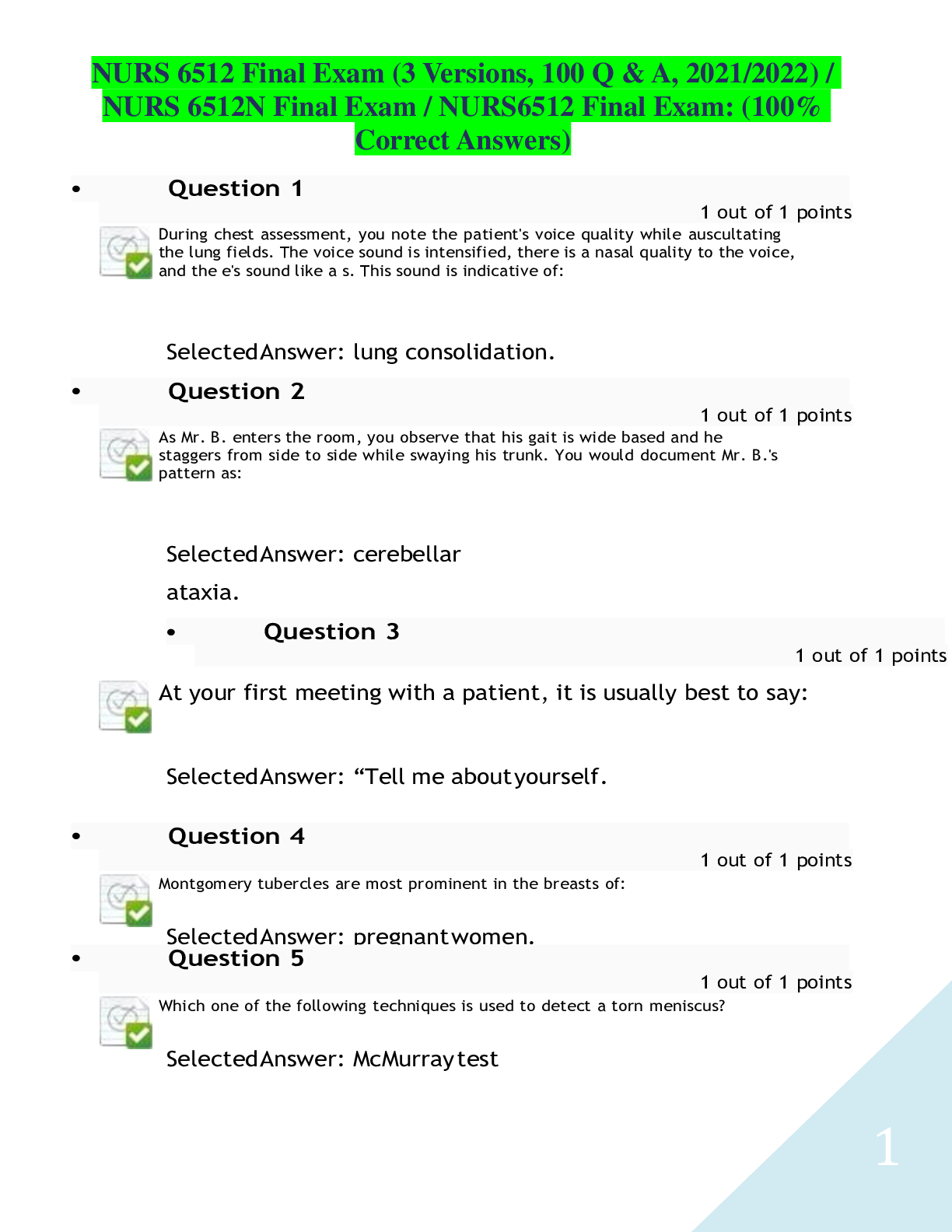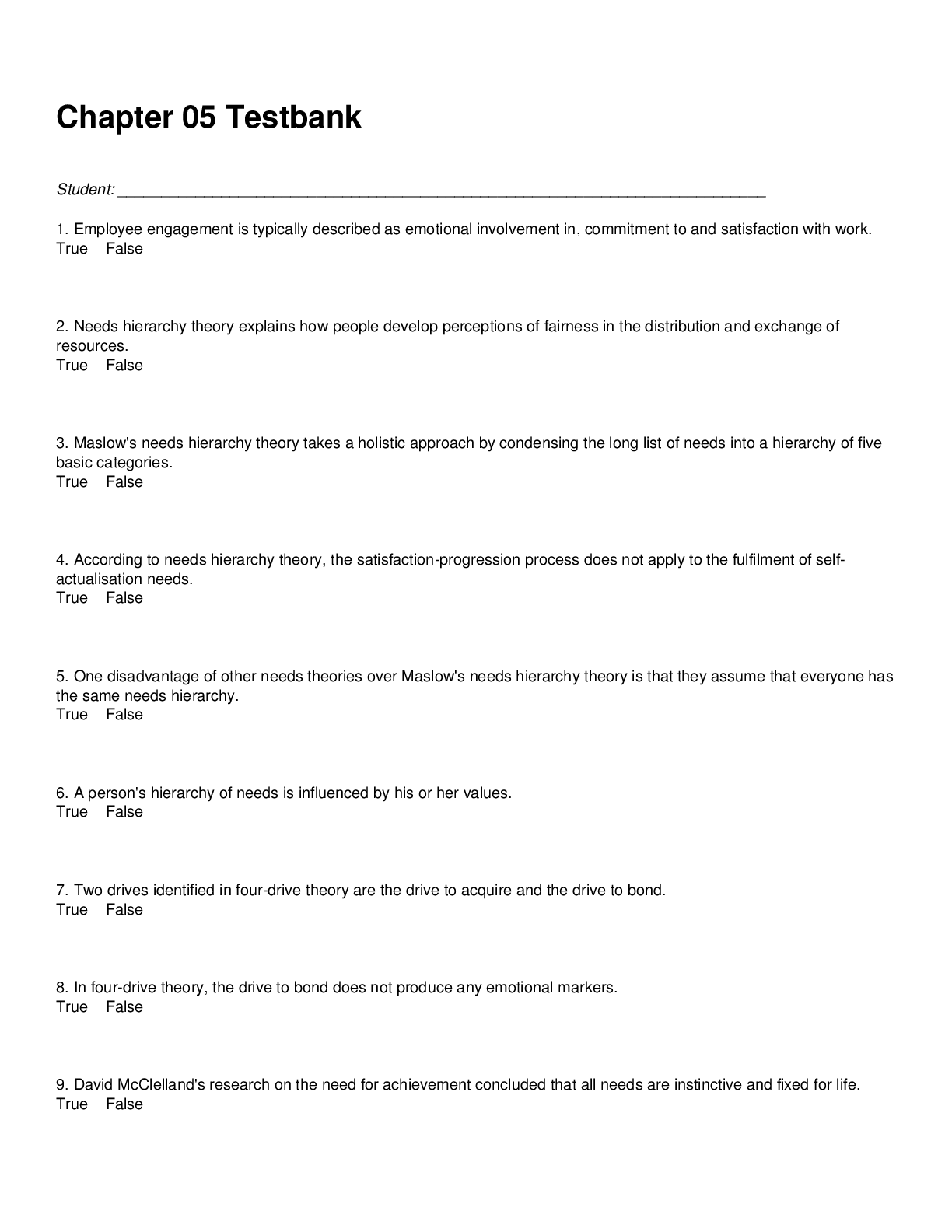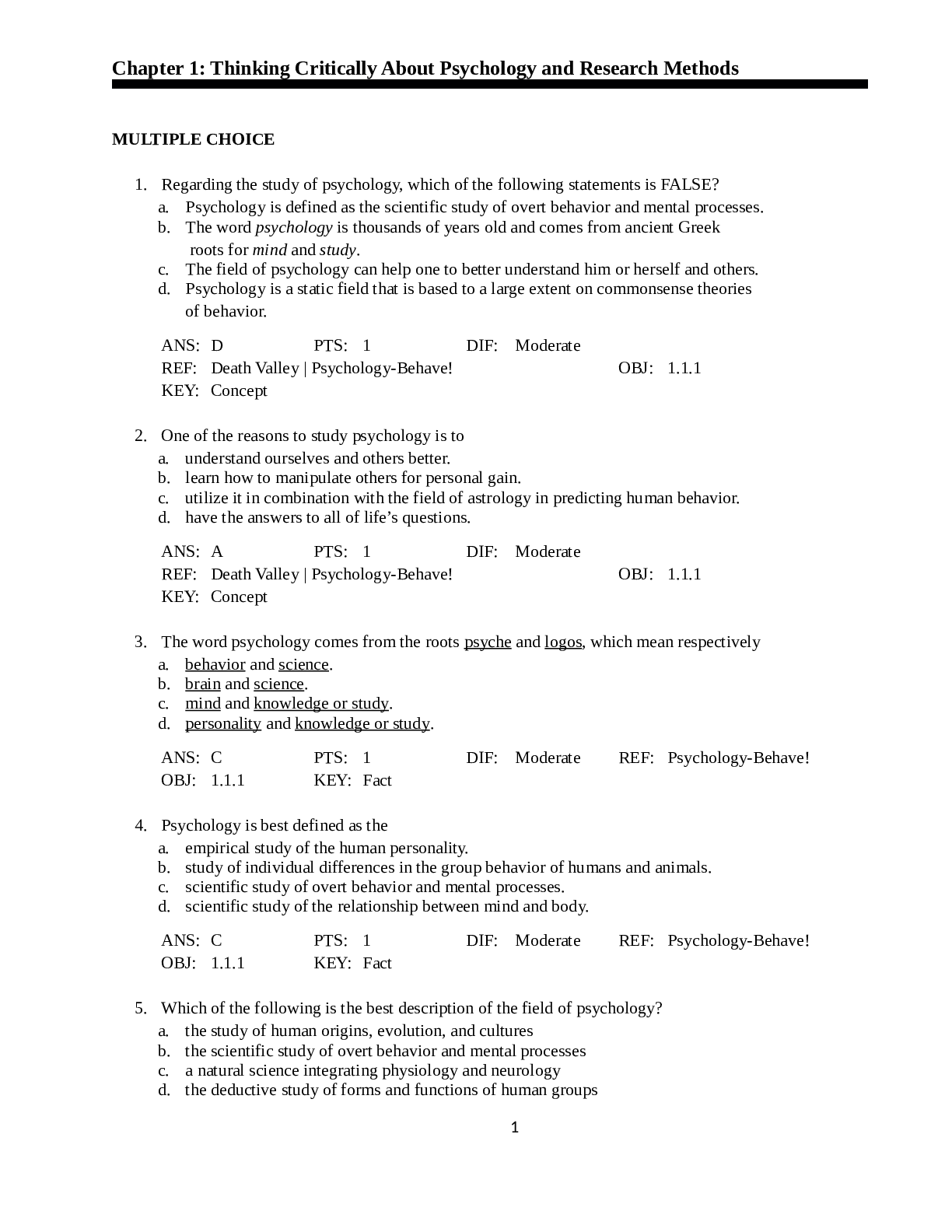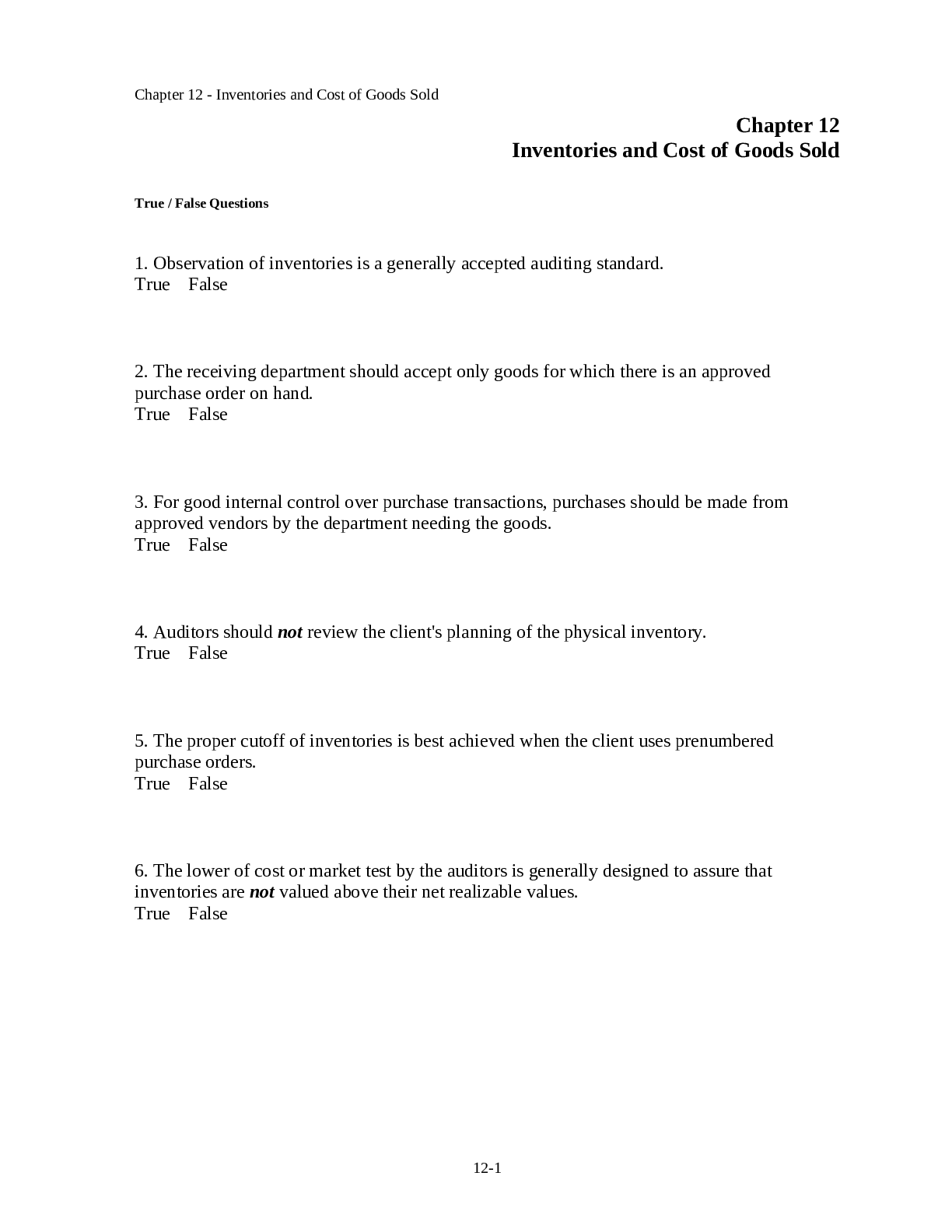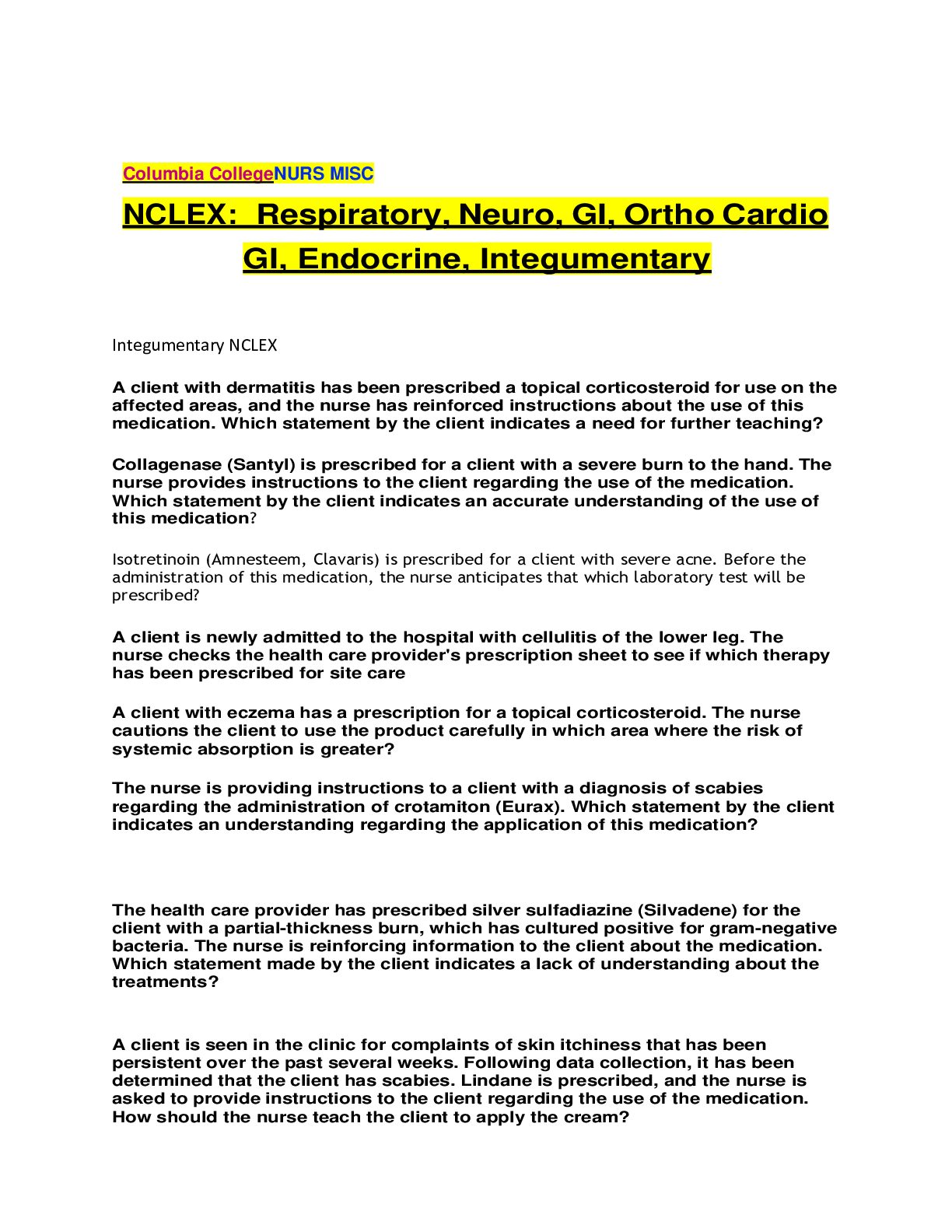Economics > TEST BANK > Wilfrid Laurier UniversityECONOMICS 238c1 ( 166 QUESTIONS WITH 100 % CORRECT ANSWERS ) WITH ANSWER K (All)
Wilfrid Laurier UniversityECONOMICS 238c1 ( 166 QUESTIONS WITH 100 % CORRECT ANSWERS ) WITH ANSWER KEY
Document Content and Description Below
c1 Student: ___________________________________________________________________________ 1. In order for something to be called an organization it must have buildings and equipment. True False 2. ... More than 1,000 years ago, Chinese factories were producing 125,000 tons of iron each year. True False 3. All organizations have a collective sense of purpose. True False 4. Social entities are called organizations only when their members work interdependently toward some purpose. True False 5. Scholars have been studying organizational behaviour since the days of Greek philosophers. True False 6. The study of OB wasn't formally organized until the 1970s. True False 7. Organizational behaviour emerged as a distinct field around the 1940s. True False8. An important principle in organizational behaviour is that OB theories should never be used to question or rebuild one's mental models. True False 9. Organizational behaviour knowledge helps us influence people and organizational events. True False 10. Evidence indicates that applying organizational behaviour knowledge tends to improve the organization's financial performance. True False 11. Organizational effectiveness, and not profitability, is considered the "ultimate dependent variable" in organizational behaviour. True False 12. One problem with the term "organizational effectiveness'' is that it has too many substitute labels, and almost as many definitions. True False 13. Almost all organizational behaviour theories share an implicit or explicit objective of making organizations more effective. True False 14. The goal attainment definition of effectiveness focuses on whether the organization achieves its stated goals. True False 15. At present there is only one organizational behaviour perspective which adequately defines organizational effectiveness. True False16. The major organizational effectiveness perspectives are considered detailed extensions of the closed systems model. True False 17. The open systems perspective emphasizes that organizations are effective when they maintain a good "fit" with their external environments. True False 18. One problem with the open systems perspective is that it neglects to focus on how well the organization operates internally. True False 19. The most efficient companies are not necessarily the most effective ones. True False 20. Successful organizations need to only concentrate on achieving efficient transformation processes. True False 21. Organizational efficiency refers to the amount of outputs relative to inputs in the transformation process. True False 22. As organizations grow, they tend to develop more subsystems and coordination among them become more complex. True False 23. Knowledge management develops an organization's capacity to acquire, share, use, and store valuable knowledge. True False24. The organizational learning perspective is also known as the knowledge management perspective. True False 25. Intellectual capital includes, among other things, the knowledge captured in an organization's systems and structures. True False 26. Experimentation is considered a valid knowledge acquisition strategy. True False 27. Intellectual capital represents the stock of knowledge held by an organization. True False 28. The most obvious form of intellectual capital is one's level of education. True False 29. Human memory plays a critical role in organizational memory. True False 30. Structural capital refers to buildings and other depreciable tangible assets. True False 31. One of the fastest ways to acquire knowledge is to hire individuals or purchase entire companies that have valued knowledge. True False 32. Knowledge acquisition can only be achieved through formal education. True False33. Organizational memory includes knowledge embedded in the organization's systems and structures. True False 34. Successful organizations should never ''unlearn'' knowledge that they have previously gained, because all knowledge is valuable. True False 35. Intellectual capital includes relationship capital. True False 36. Organizational unlearning is particularly important for organizational change. True False 37. A key variable in the high-performance work practices (HPWP) model is employee competence. True False 38. The high-performance work practices perspective supports the idea that organizations should strive to find "one best way" to do things. True False 39. One criticism of the high-performance work practices perspective is that it promotes shareholder and customer satisfaction at the expense of employee well-being. True False 40. Stakeholders are individuals, organizations, or other entities that affect, or are affected by the organization. True False 41. Stockholders are stakeholders. True False42. Values represent an individual's short-term beliefs about what will happen in the future. True False 43. Values guide our preferences and motivate our actions. True False 44. Values are relatively stable, long-lasting beliefs about what is important in a variety of situations. True False 45. The concept of values is an important aspect of the stakeholder perspective. True False 46. Ethics refers to the study of moral principles or values that determine whether actions are right or wrong and outcomes are good or bad. True False 47. One reason why workplace values have become more important is that employees increasingly value command-and-control direct supervision. True False 48. One survey reported that most Canadian would choose to leave their current job for a more environmentally friendly employer. True False 49. The "triple-bottom-line" philosophy says that successful organizations focus on financial performance three times more often than do less successful organizations. True False 50. According to a recent survey, 93 percent of Canadians believe that corporate social responsibility is as important to companies as profit and shareholder value. True False51. The integrative model of organizational behaviour ties individual and team processes, and outcomes to organizational effectiveness. True False 52. In the integrative model of organizational behaviour, individual outcomes are referred to as the ultimate dependent variable. True False 53. Globalization may have both positive and negative implications for people working in organizations. True False 54. Reduced job security and increased work intensification may be partly caused by globalization. True False 55. Three of the most prominent workforce diversity forms are: age, ethnicity, and occupation. True False 56. Surface-level diversity refers to observable demographic and other overt differences in people. True False 57. People born between 1946 and 1964 are referred to as Baby Boomers. True False 58. Workforce diversity does not consider the differences in psychological characteristics of employees. True False59. According to your text, 47 percent of Canadians identify themselves as members of a visible minority group. True False 60. Research indicates that baby boomers and Generation X employees bring the same values and expectations to the workplace. True False 61. Studies suggest that deep-level diversity exists across generations. True False 62. According to one study, Millennials and Gen-Xers value extrinsic rewards significantly more than Boomers. True False 63. Workforce diversity potentially improves decision making and team performance on complex tasks. True False 64. When we describe multiculturalism we are primarily referring to surface-level diversity. True False 65. Teams with diverse members usually take longer to perform effectively. True False 66. The emerging employment relationship in Canada is that people must give up their legal rights regarding employment discrimination in return for long-term employment. True False 67. One employment relationship trend is the focus away from work-life balance and virtual work, because of the extra stress these place on workers. True False68. According to recent surveys about one-third of Canadians would take a pay cut to improve their work-life balance. True False 69. One of the most consistent observations is that telework is ranked as one of the most popular perks. True False 70. Work-life balance refers to the length of time one remains in the workforce during one's lifetime. True False 71. Work-live balance refers to minimizing conflict between work and nonwork demands. True False 72. Teleworking forces employers to evaluate employee performance based on ''face time'' rather than work output. True False 73. Successful teleworkers tend to be self-motivated and are able to fulfill their social needs outside of the work context. True False 74. In virtual work, employees rely on information technology to perform jobs away from the traditional workplace. True False 75. Telecommuting is the most common form of virtual work. True False 76. Most organizational behaviour theories have been developed by OB scholars rather than from other disciplines. True False77. Psychology and sociology have contributed many theories and concepts to the field of organizational behaviour. True False 78. Communications, marketing, and information systems are three emerging fields from which organizational behaviour is now acquiring knowledge. True False 79. Sociology is one of the few disciplines that has not made any contribution to organizational behaviour knowledge. True False 80. The field of organizational behaviour relies on common sense to understand organizational phenomena. True False 81. The systematic research anchor relies mainly on qualitative data and subjective procedures to test hypothesis. True False 82. The contingency anchor in organizational behaviour suggests that a particular action may have different consequences in different situations. True False 83. Most organizational events may be studied from all three levels of analysis: individual, team, and organization. True False 84. The contingency anchor in organizational behaviour suggests that we need to diagnose the situation to identify the most appropriate action under those specific circumstances. True False85. Which of these statements about the field of organizational behaviour is FALSE? A. Organizational behaviour scholars study individual, team, and structural characteristics that influence behaviour within organizations. B. Leadership, communication, and other organizational behaviour topics were not discussed by scholars until the 1940s. C. Organizational behaviour emerged as a distinct field around the 1940s. D. The field of OB has adopted concepts and theories from other fields of inquiry. E. OB scholars study what people think, feel, and do in and around organizations. 86. Which of these statements about the field of organizational behaviour is TRUE? A. Organizational behaviour emerged as a distinct field during the 1980s. B. The origins of some organizational behaviour concepts date back to Plato and other Greek philosophers. C. Information technology has almost no effect on organizational behaviour. D. The field of organizational behaviour relies exclusively on ideas generated within the field by organizational behaviour scholars. E. The origins of organizational behaviour are traced mainly to the field of economics. 87. In the field of organizational behaviour, organizations are best described as: A. legal entities that must abide by government regulations and pay taxes. B. physical structures with observable capital equipment. C. social entities with a publicly stated set of formal goals. D. groups of people who work interdependently towards some purpose. E. any social entity with profit-centred motives and objectives. 88. Organizational behaviour knowledge: A. originates mainly from models developed in chemistry and other natural sciences. B. accurately predicts how anyone will behave in any situation. C. is more appropriate for people who work in computer science than in marketing. D. helps us to understand and influence the behaviours of others in organizational settings. E. None of the answers apply. 89. According to the author of Canadian Organizational Behaviour, organizational behaviour knowledge: A. should never be used to influence the behaviour of other people. B. should be used mostly by managers and senior executives. C. should never replace your common sense knowledge about how organizations work. D. is relevant to everyone who works in organizations. E. should never be used to influence the behaviour of other people and should be used mostly by managers and senior executives.90. Which of these statements about the field of OB is FALSE? A. Organizational behaviour scholars study individual, team, and structural characteristics that influence behaviour within organizations. B. The field of OB has adopted concepts and theories from other fields of inquiry. C. Organizational behaviour emerged as a distinct field around the 1940s. D. Given the specific utility of the field, OB is useful for the managers in the organizations and not the employees. E. OB scholars study what people think, feel, and do in and around organizations. 91. Which of the following perspective is consistent with the concept of organizational effectiveness? A. Open systems perspective B. Organizational learning perspective C. High-performance work practices perspective D. Stakeholder perspective E. All the answers are correct. 92. Which of the following is included in the open systems perspective of organizations? A. Inputs B. Subsystems C. Outputs D. Feedback from the environment E. All of the answers are correct. 93. The open systems perspective of organizational behaviour states that: A. organizations take their sustenance from the environment and in turn affect that environment. B. organizations can operate efficiently by focussing on what they do best and ignoring changes in the external environment. C. people are the only important and valued organizational input. D. organizations should be viewed as machines with one working part. E. All of the answers are correct.94. ACME Software Ltd has developed a training program to make employees more aware of how their job performance affects customers and other employees within the organization. This training program relates most closely with which of the following concepts? A. Contingency anchor B. Grounded theory C. Open systems perspective D. Marketing principles E. Organizational efficiency 95. Which organizational behaviour perspective discusses inputs, outputs, and feedback? A. Mechanistic perspective B. Open systems perspective C. Goal-attainment perspective D. Organizational learning perspective E. Stakeholder perspective 96. Which of the following relates to the perspective that organizations are open systems? A. The organization adjusts its services to satisfy changing consumer demand. B. The organization finds a substitute resource in anticipation of a future shortage of the resource previously used to manufacture the product. C. Production and sales employees coordinate their work activities to provide a more efficient work process. D. The organization changes its products to suit customer needs. E. All of the answers are correct. 97. The amount of outputs relative to inputs in the organization's transformation process is referred to as: A. organizational efficiency B. organizational effectiveness C. organizational deficiency D. transformational quotient E. organizational footprint98. Knowledge management is an extension of: A. traditional accounting methods of measuring corporate assets. B. the organizational learning perspective of organizational behaviour. C. microeconomic principles of supply and demand. D. the efficiency model of industrial engineering. E. None of the answers apply. 99. Intellectual capital refers to: A. how much money an organization spends on training and development. B. the stock of knowledge that resides in an organization. C. the percentage of information available that is actually used productively by the organization. D. the total cost of computers and other ''intelligent'' machines in the organization. E. the cost of hiring a typical employee. 100. Intellectual capital consists of: A. knowledge that employees possess and generate. B. the knowledge captured in an organization's systems and structures. C. the value of the organization's relationship with customers. D. All of the answers are correct. E. knowledge that employees possess and generate and the knowledge captured in an organization's systems and structures. 101. A computer maintenance company wants to ''capture'' the knowledge that employees carry around in their heads by creating a database where employees document their solutions to unusual maintenance problems. This practice tries to: A. transform intellectual capital into knowledge management. B. transfer human capital into structural capital. C. prevent relationship capital from interfering with human capital. D. reduce the amount of human capital. E. transfer structural capital into relationship capital. 102. The organizational learning perspective states that an organization's effectiveness depends on: A. extracting information and ideas from the external environment and through experimentation. B. ensuring that knowledge is shared throughout the organization. C. ensuring that employees effectively use the knowledge available to them. D. All of the answers are correct. E. ensuring that knowledge is shared throughout the organization and that employees effectively use the knowledge available to them.103. Which of the following is a form of knowledge acquisition? A. Hiring job applicants. B. Research and development. C. Information sessions where employees describe to colleagues unique incidents involving customers. D. All of the answers are correct. E. Hiring job applicants and research and development. 104. Which of the following is an example of knowledge acquisition? A. Surveying employees about their attitudes towards recent corporate changes. B. Developing a training program for employees to learn the latest software for their jobs. C. Encouraging employees to share their knowledge with coworkers. D. Hiring people who bring valuable knowledge that is not available from current employees. E. All of the answers are examples of knowledge acquisition. 105. Organizational memory refers to: A. its ability to hire more people with good memorization skills. B. its level of current knowledge so it can bring in new knowledge from the environment. C. its storage and preservation of intellectual capital. D. its ability to unlearn knowledge. E. its ability to conduct memorable work. 106. A technology company wants to move into the field of wireless communications. Unfortunately, few of its employees know enough about the basic technology to acquire emerging knowledge about that field or to launch a separate business unit to enter that market. With respect to learning about wireless technology knowledge, this organization has: A. too much structural capital. B. low organizational memory. C. high human capital but low relationship capital. D. too much of an open system. E. low human capital. 107. As part of the knowledge management process, experimentation mainly affects: A. measuring intellectual capital B. knowledge acquisition C. organizational memory D. knowledge sharing E. unlearning108. Eastern University performs a daily computer search through newspaper articles to identify any articles about the university or its faculty members. University administrators use this information to receive feedback about how the public reacts to university activities. In knowledge management, searching for newspaper articles and other external writing about the organization is mainly a form of: A. knowledge acquisition B. communities of practice C. organizational unlearning D. knowledge sharing E. documentation 109. Twice each year, a major car parts manufacturer brings together production and engineering specialists from its eight divisions to discuss ideas, solutions, and concerns. This helps to minimize the ''silos of knowledge'' problem that exists in many organizations. This practice is primarily an example of: A. relationship capital B. experimentation C. knowledge sharing D. documentation E. organizational unlearning 110. Organizational memory is best described as: A. the total terabytes of hard disk space available on computers throughout an organization. B. the ability of senior executives to recall important information about the company's products, services, and employees. C. the storage and preservation of intellectual capital within an organization. D. the ability of employees throughout the organization to recall important information about the company's products and services. E. the extent to which potential customers are able to recall specific products and services provided by an organization. 111. Organizations can retain intellectual capital by: A. transferring human capital into structural capital. B. encouraging employees to take early retirement. C. discouraging employees from communicating with each other. D. All of the answers are correct. E. None of the answers apply.112. Which of the following typically results in a loss of organizational memory? A. The processes used to make a unique product are incorrectly documented. B. The company lays off nearly one-quarter of its workforce. C. The company sells one of its divisions (including employees in that division) to another organization. D. All of the answers are correct. E. The processes used to make a unique product are incorrectly documented and the company lays off nearly one-quarter of its workforce. 113. Organizations should ''unlearn'': A. in many situations involving organizational change. B. whenever new knowledge is brought into the organization. C. whenever the organization shifts from communities of practice to experimentation in the knowledge acquisition process. D. All of the answers are correct. E. None of the answers apply. 114. The relatively new field of research that has emerged with the objective of identifying internal systems and structures that are associated with successful companies is called: A. the organizational behaviour systems perspective. B. the comparative organizations perspective. C. the organizational learning perspective. D. the organizational effectiveness perspective. E. the high-performance work practices perspective. 115. Which of the following best describes the high-performance work practices perspective? A. Organizations that want to be effective should strive for "one best practice" strategy. B. A particular action may have different consequences depending on the situation. C. All organizations should be viewed as being made up of many different parts which contribute to high performance. D. Effective organizations incorporate several workplace practices that leverage the potential of human capital. E. All of the answers are correct.116. Two of the most widely mentioned high-performance work practices in organizational behaviour are: A. effective recruitment and hiring practices. B. ethical business practices and corporate social responsibility. C. avoiding counterproductive work behaviours and increasing workforce diversity. D. minimizing political behaviours and encouraging cooperation among organizational members. E. increasing employee involvement and job autonomy. 117. Which of the following is NOT a concern expressed with respect to high-performance work practices (HPWP) perspective? A. HPWPs increase work stress for employees. B. Even when HPWPs are successful, management is reluctant to share the financial benefits with workers. C. The HPWP perspective lacks theoretical understanding of why such practices improve performance. D. HPWPs satisfy shareholder and customer needs at the expense of employee wellbeing. E. The HPWP perspective fails to consider the impact of such practices on the environment and society. 118. Stakeholders include: A. shareholders B. employees C. suppliers D. governments E. All of the answers are correct. 119. Employees, suppliers, and governments: A. are organizational stakeholders. B. are rarely considered in organizational behaviour theories. C. represent the three levels of analysis in organizational behaviour. D. are excluded from the open systems anchor. E. All of the answers are correct. 120. Stable, long-lasting beliefs about what is important in a variety of situations are: A. called intellectual capital. B. the foundations of the open systems anchor. C. the main reason why organizations fail to adapt. D. rarely studied in the field of organizational behaviour. E. called values.121. Values have become more important in organizational behaviour because of: A. increased demand for corporate social responsibility. B. increased pressure on organizations to engage in ethical practices. C. direct supervision is expensive and incompatible to today's workforce. D. All of the answers are correct. E. None of the answers apply. 122. The topic of ethics is most closely associated with: A. workplace values. B. the scientific method. C. workforce diversity. D. the open systems anchor. E. the contingency approach to organizational behaviour. 123. Corporate social responsibility is most closely related to which of these organizational behaviour trends? A. Workforce diversity. B. Employment relationships. C. Virtual work. D. Globalization. E. Workplace values and ethics. 124. The triple-bottom-line philosophy says that: A. companies should pay three times more attention to profits than to employee wellbeing. B. the main goal of all companies is to satisfy the needs of three groups: employees, shareholders, and suppliers. C. business success increases by having three times more contingent workers than permanent employees. D. companies should pay attention to local, national, and global customers. E. companies should try to support the economic, social, and environmental spheres of sustainability. 125. Which of the following concept is most closely associated with corporate social responsibility? A. knowledge management B. sociological theories C. entrepreneurship D. open systems perspective E. triple-bottom-line philosophy126. Which of these statements about corporate social responsibility (CSR) is FALSE? A. Most companies now publically report on their CSR practices. B. CSR emphasizes the economic, social, and environmental spheres of sustainability. C. Most Canadians expect companies to engage in CSR. D. CSR is closely related to the topics of values and ethics. E. An organization's perceived level of CSR influences whether people apply for work with that organization. 127. Which of the following is NOT considered an individual outcome in the integrative model of organizational behaviour? A. Behaviour B. Decisions C. Social networks D. Well-being E. Organizational citizenship 128. According to the integrative model of organizational behaviour, which of the following is classified as an organizational input? A. Motivation B. Organizational citizenship C. Social networks D. Organizational culture E. Communication 129. Which of these statements about globalization and organizational behaviour is TRUE? A. Globalization has little or no effect on organizational behaviour. B. Globalization has forced organizational behaviour researchers to study only large multinational businesses. C. Globalization emphasizes the need to recognize the contingencies of effective organizational behaviour practice in diverse cultures. D. Globalization has forced organizational behaviour textbooks to study only companies with headquarters in North America. E. Globalization has forced organizational behaviour researchers to study only large multinational businesses and forced organizational behaviour textbooks to study only companies with headquarters in North America.130. Globalization occurs when an organization: A. actively participates in other countries and cultures. B. serves diverse customers within the firm's home country. C. has a diverse workforce within the firm's home country. D. All of the answers are correct. E. serves diverse customers within the firm's home country and has a diverse workforce within the firm's home country. 131. Workforce diversity: A. includes the entry of younger people to the workforce. B. can potentially improve decision making and team performance in organizations. C. is increasing in Canada. D. includes the increasing proportion of visible minorities in the workforce. E. All of the answers are correct. 132. Which of the following is considered surface-level diversity? A. Physical qualities. B. Gender. C. Ethnicity. D. Age E. All of the answers are correct. 133. Personalities, beliefs, values, and attitudes are: A. secondary categories of workforce diversity. B. primary categories of workforce diversity. C. categories of deep-level workforce diversity. D. not considered categories of diversity. E. a result of generational psychometrics. 134. Which of the following statements is TRUE? A. Canada is becoming a more homogeneous society. B. Deep-level diversity includes characteristics over which we have some control. C. Most Canadians believe that the government should disband multiculturalism. D. Diversity offers tremendous advantages to organizations with almost no disadvantages. E. Nearly one-half of all immigrants to Canada over the past decade were born in the United States.135. Which of the following statements about Canada's population and workforce is FALSE? A. More than half of immigrants to Canada over the past decade were born in Europe. B. The participation of visible minorities in the workforce has increased over the past few decades. C. Generation X employees bring somewhat different needs and expectations to the workplace than their Baby Boomer counterparts. D. Canada is becoming a more multicultural society. E. Workforce diversity presents both opportunities and challenges to organizations. 136. Which of the following statements is FALSE? A. Employment relationships are shifting towards the idea that companies must provide employees a high degree of job security, possibly even a job for life. B. Generation X employees bring somewhat different values and needs to the workplace than those of baby boomers. C. The workforce is becoming more diverse. D. Successful firms increasingly rely on values rather than direct supervision to guide employee decisions and behaviour. E. More work-life balance is an emerging issue in the employment relationship. 137. Virtual work: A. is more common in Canada than in the United States. B. occurs when job applicants are asked to pretend they are performing the job in the interview setting in order to determine their ability to perform that work. C. tends to improve an employee's social involvement in the organization. D. can potentially reduce employee stress. E. None of the answers apply. 138. The degree to which a person minimizes conflict between work and nonwork demands refers to: A. life choice balance. B. stress management. C. quality of life issues. D. Personal-professional actualization. E. None of the answers apply.139. According to a recent survey how many Canadians would be willing take a pay cut to improve their work-life balance? A. One-third would agree. B. Nearly half would refuse. C. Fewer than 10 percent would accept. D. Nearly no one would agree. E. None of the answers apply. 140. What effect does teleworking have in the workplace? A. Teleworking tends to improve the teleworker's work-life balance. B. Teleworking forces corporate leaders to evaluate employees more from their work results rather than their ''face time''. C. Under some circumstances, teleworking increases the teleworker's productivity. D. Teleworking increases the risk that employees feel socially isolated from each other. E. All of the answers are correct. 141. Which of the following is NOT a benefit of telecommuting according to research? A. It reduces stress. B. It improves job satisfaction. C. It makes employees feel more empowered. D. It reduces costs for the employer. E. It reduces pollution. 142. Which of the following is NOT a conceptual anchor in organizational behaviour? A. Contingency anchor B. Systematic research anchor C. Organizational effectiveness anchor D. Multidisciplinary anchor E. Multiple levels of analysis anchor 143. Which of the following does NOT represent a belief that anchors organizational behaviour? A. OB should view organizations as closed systems. B. OB should assume that the effectiveness of an action usually depends on the situation. C. OB should draw on knowledge from other disciplines. D. OB should rely on the systematic research methods to generate knowledge. E. OB topics can be studied from multiple levels of analysis.144. Which of the following statements about the field of organizational behaviour is FALSE? A. OB is the study of what people think, feel, and do in and around organizations. B. OB emerged as a distinct field of inquiry in the 1940s. C. OB is a self-contained discipline, independent of other disciplines. D. OB theories are usually tested using the scientific method. E. Many OB theories are contingency-oriented. 145. Which of these statements is consistent with the four anchors of organizational behaviour? A. Organizational behaviour theories must apply universally to every situation. B. Organizations are like machines that operate independently of their external environment. C. Each OB topic relates to only one level of analysis. D. The field of organizational behaviour should rely on other disciplines for some of its theory development. E. None of these statements is consistent with the OB anchors. 146. Which discipline has provided organizational behaviour with much of its theoretical foundation for team dynamics, organizational power, and organizational socialization? A. Sociology B. Psychology C. Economics D. Industrial engineering E. Political science 147. Which of the following is identified as an emerging field from which organizational behaviour is acquiring new knowledge? A. Industrial engineering B. Information systems C. Anthropology D. Economics E. Psychology 148. To form research questions, collect data, and test hypotheses against those data organizational behaviour scholars rely on: A. systematic research. B. closed systems theory. C. grounded theory. D. All of the answers are correct. E. contingency theory.149. Which of the following is NOT an anchor of organizational behaviour? A. Contingency anchor B. Open systems anchor C. Multidisciplinary anchor D. Systematic research anchor E. Multiple levels of analysis anchor 150. The contingency anchor of organizational behaviour states that: A. we should have a second OB theory to explain the situation in case our first choice doesn't work. B. OB theories must view organizations as systems that need to adapt to their environments. C. there is usually one best way to resolve organizational problems. D. a particular action may have different consequences in different situations. E. All of the answers are correct. 151. According to the multiple levels of analysis anchor: A. organizational behaviour is mainly the study of how all levels of the organizational hierarchy interact with the external environment. B. OB topics typically relate to the individual, team, and organizational levels of analysis. C. there are eight levels of analysis that scholars should recognize when conducting OB research. D. organizational events can be studied from only one level of analysis. E. our understanding of organizational behaviour increases with the level of mathematical analysis applied to create the models. 152. Which of the following is an anchor of organizational behaviour knowledge? A. diversity anchor. B. stakeholder anchor. C. open systems anchor. D. socioeconomic anchor. E. multiple levels of analysis anchor.153. Marketing specialists at Napanee Beer Co. developed a new advertising campaign for summer sales. The ads were particularly aimed at sports events where Napanee Beer sold kegs of beer on tap. The marketing group worked for months with a top advertising firm on the campaign. Their effort was successful in terms of significantly higher demand for Napanee Beer's keg beer at sports stadiums. However, the production department had not been notified of the marketing campaign and was not prepared for the increased demand. The company was forced to buy empty kegs at a premium price. It also had to brew some of the lower-priced keg beer in vats that would have been used for higherpriced specialty beer. The result was that Napanee Beer sold more of the lower-priced keg beer and less of the higher-priced products that summer. Moreover, the company could not initially fill consumer demand for the keg beer, resulting in customer dissatisfaction. Use open system perspective to explain what has occurred at Napanee Beer Co. 154. Senior officers in a national military organization decided that operations in supplies requisition were inefficient and costly. They brought in consultants who recommended that the entire requisition process be ''reengineered''. This involved throwing out the old practices and developing an entirely new set of work activities around workflow. However, contrary to expectations, this intervention resulted in lower productivity, higher employee turnover and other adverse outcomes. Discuss likely problems with the intervention in terms of open systems perspective. 155. An aircraft manufacturing company developed a computer simulation representing the very complex processes and subgroups that create an airplane. Teams of production employees would participate in a game where trainers gave them the challenge of reducing costs or minimizing space using the simulation. As the trainers predicted, the team's actions would almost always result in unexpected consequences. Explain how this simulation relates to the open systems perspective of organizational behaviour.156. WindTunnel Ltd, a manufacturer of commercial vacuum cleaner systems, has heard about new computer-based technologies that help vacuum cleaner systems to work more efficiently and provide additional features to users. So far, only one British vacuum cleaner company has apparently moved to integrate this technology into its products, but more firms will soon follow. Senior executives at WindTunnel are also aware of a small engineering firm that has applied similar computer technology to military suction-like products. No one at WindTunnel has much experience or knowledge with this computer technology, yet the company needs such expertise quickly. Explain which knowledge acquisition strategy would best help WindTunnel to gain the necessary intellectual capital. 157. Comment on the accuracy of the following statement: ''Without employees, an organization has no organizational memory.'' 158. A courier service laid off a large percentage of its production staff during last year's recession. These low-skilled employees performed routine tasks filling orders. The company now wants to rehire them. However, most of the unskilled employees have since found employment in other companies and industries. Do you think the courier company lost much organizational memory in this situation? Explain your answer.159. Comment on the accuracy of the following statement: ''An important objective in knowledge management is to ensure that intellectual capital is stored and preserved.'' 160. The high-performance work practices (HPWP) perspective holds that effective organizations incorporate several workplace practices to harness the potential of human capital. What common activities do high performance organizations practice? 161. There is an increased interest by organizations about the importance of values in the workplace. Explain the difference between values, ethics and corporate social responsibilities. 162. Many organizations are placing increasing importance on values and ethics in the workplace. Discuss two reasons why workplace values have become more important in recent years. Your answer should briefly define values and ethics.163. The changing workforce is one of the emerging trends in organizational behaviour. Describe how the workforce is changing and briefly identify two consequences of these changes for organizations. 164. Virtual work has been identified as an important trend in organizational behaviour. Discuss three organizational behaviour topics that are influenced by virtual work. 165. Discuss the four anchors of organizational behaviour. 166. Two organizational behaviour students are debating the idea that many OB theories are contingency-oriented. One student believes that every OB theory should be contingency-oriented. The other student disagrees, saying that most theories should try to be universal. Evaluate both positions and provide your opinion on this issue. [Show More]
Last updated: 1 year ago
Preview 1 out of 82 pages
.png)
Reviews( 0 )
Document information
Connected school, study & course
About the document
Uploaded On
Jul 02, 2021
Number of pages
82
Written in
Additional information
This document has been written for:
Uploaded
Jul 02, 2021
Downloads
0
Views
103


.png)
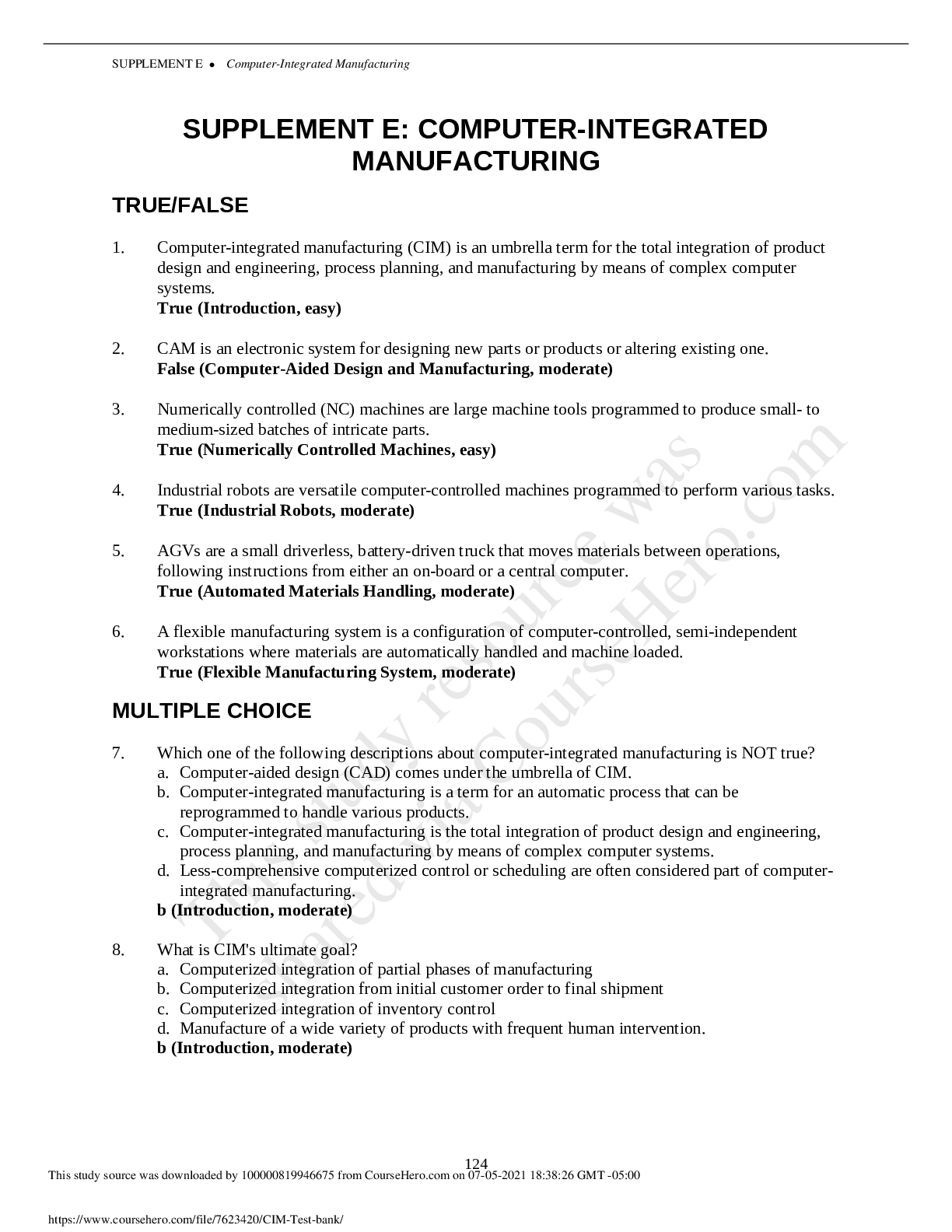


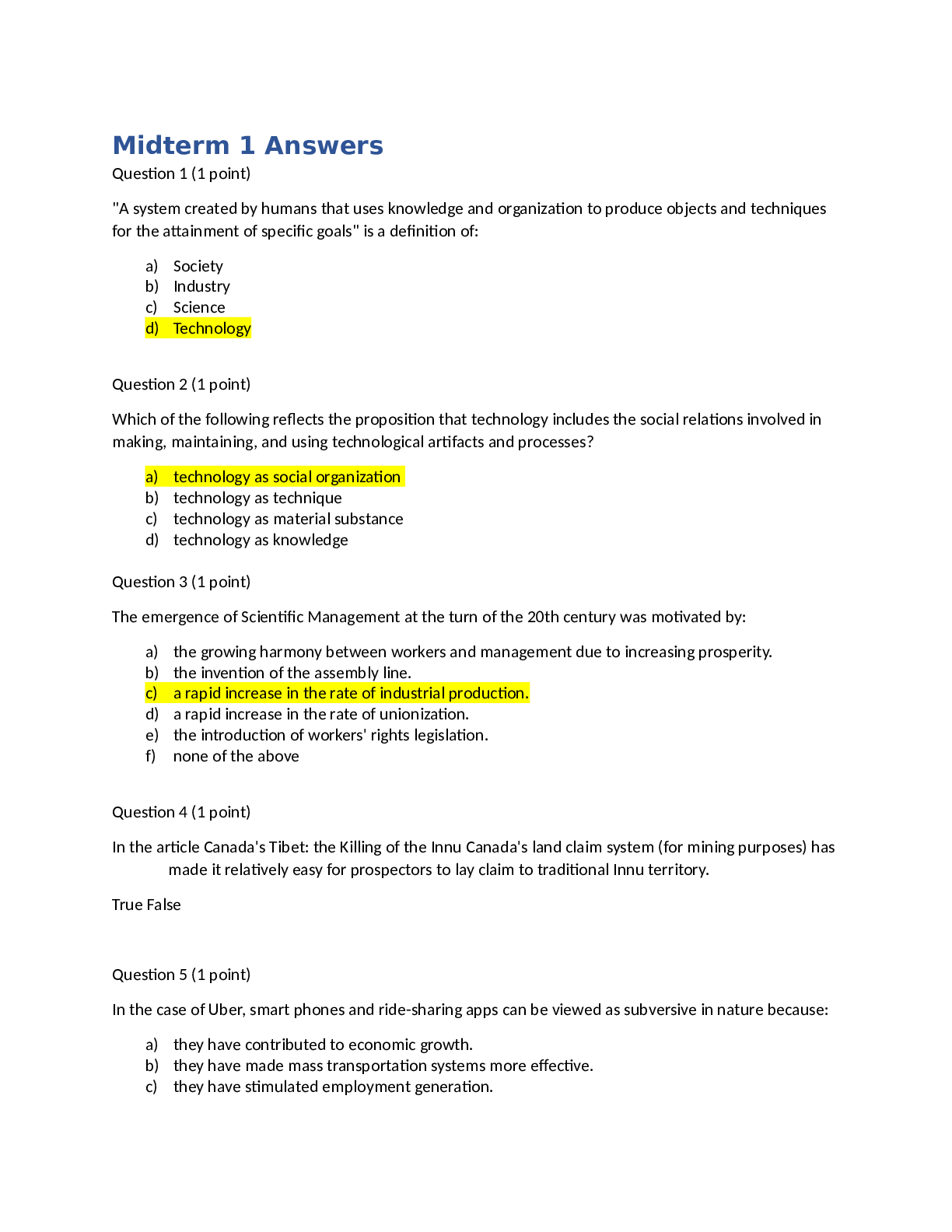


 David L.png)
.png)
